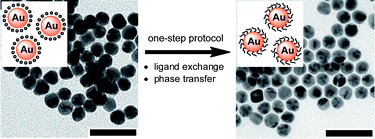Synthesis and characterization of azidoalkyl-functionalized gold nanoparticles as scaffolds for “click”-chemistry derivatization
Abstract
We demonstrate how water-soluble

* Corresponding authors
a
Department of Chemistry, University of Missouri-Kansas City, 5100 Rockhill Road, Kansas City, MO, USA
E-mail:
kadnikovae@umkc.edu
Fax: +1 816 235 5502
Tel: +1 816 235 5937
We demonstrate how water-soluble

 Please wait while we load your content...
Something went wrong. Try again?
Please wait while we load your content...
Something went wrong. Try again?
D. Baranov and E. N. Kadnikova, J. Mater. Chem., 2011, 21, 6152 DOI: 10.1039/C1JM10183H
To request permission to reproduce material from this article, please go to the Copyright Clearance Center request page.
If you are an author contributing to an RSC publication, you do not need to request permission provided correct acknowledgement is given.
If you are the author of this article, you do not need to request permission to reproduce figures and diagrams provided correct acknowledgement is given. If you want to reproduce the whole article in a third-party publication (excluding your thesis/dissertation for which permission is not required) please go to the Copyright Clearance Center request page.
Read more about how to correctly acknowledge RSC content.
 Fetching data from CrossRef.
Fetching data from CrossRef.
This may take some time to load.
Loading related content
